Effective financial planning is essential for a secure retirement, requiring a detailed evaluation of one's financial situation and a proactive approach to address various needs. Building wealth and ensuring financial stability in retirement is rooted in thoughtful and diligent planning. Let's explore crucial aspects and strategies integral to robust retirement planning.
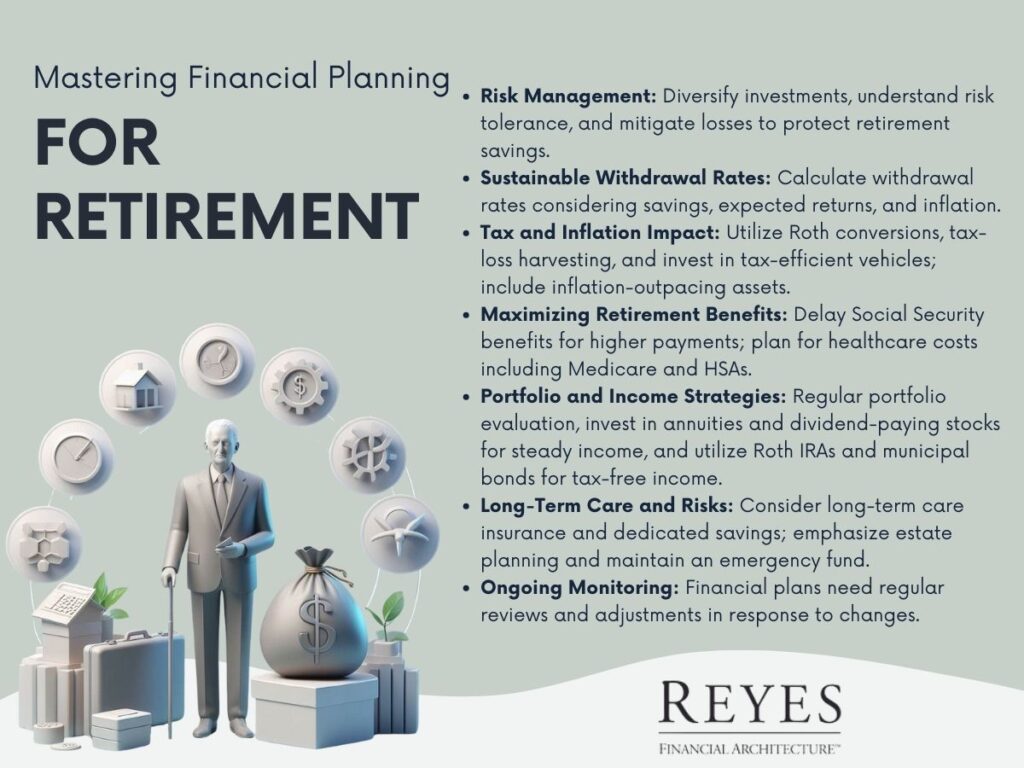
Financial planning for retirement is intricate but indispensable. It demands a comprehensive approach that addresses factors like risk management, tax implications, inflation, healthcare costs, and more. A well-structured financial plan focuses on not just accumulating wealth but also on preserving and efficiently distributing it. By tackling these essential questions and adapting to evolving circumstances, one can develop a robust financial plan capable of withstanding future uncertainties.
In essence, a thorough and proactive approach to financial planning is key to achieving a secure and enjoyable retirement.
September 21st, 2020 - Market Update - Time To Panic?
In recent times, the financial markets have been experiencing unprecedented levels of volatility, leaving investors on edge and uncertain about the future. David Reyes, a financial architect, has been closely monitoring these developments and believes it's crucial to provide regular updates on the situation. In this article, we will delve into the reasons behind the market's turbulence and explore strategies to safeguard your investments during these uncertain times.
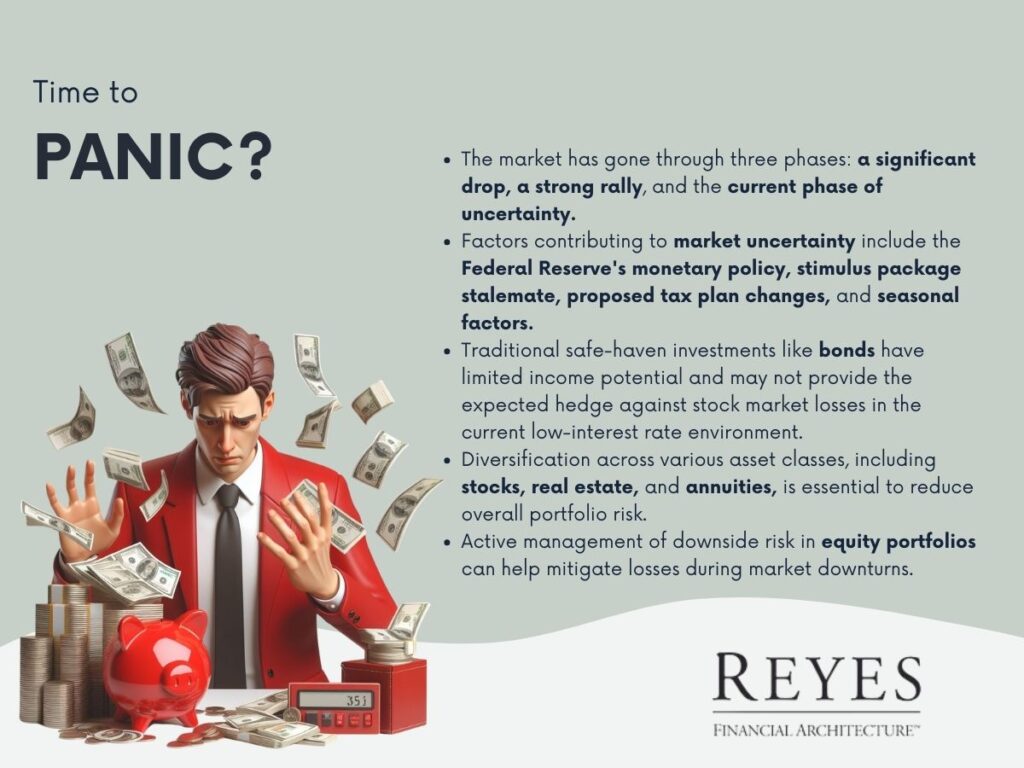
David Reyes begins by discussing the three phases of a market downturn. Phase one occurred earlier in the year when the market plummeted by 35 percent in just six weeks, from February into March. This dramatic drop was followed by a remarkable 60 percent rally, which brought the market back to near-even levels by September. This phase marked the classic characteristics of bear markets.
Currently, the market is in phase three, characterized by significant uncertainty. Since September, the NASDAQ has declined by 12 percent, while the S&P 500 has fallen by 8 percent in just three weeks. These rapid fluctuations have raised concerns about the market's stability.
Several factors contribute to the current uncertainty in the financial markets:
The Federal Reserve recently announced that it would keep interest rates at near-zero levels for the next three years. While this policy aims to stimulate economic growth, it has negative consequences for savers, who see minimal returns on their investments.
The ongoing political turmoil and uncertainty surrounding the passage of a stimulus package further exacerbate market jitters. Small businesses and individuals out of work rely on this aid, and its absence could negatively impact the economy and the stock market.
President Biden's proposed tax plan, which includes increasing capital gains tax rates from 23 percent to 38 percent, has raised concerns among investors. Similar tax increases in the past have led to asset sales, causing market downturns.
Historically, September and October have been challenging months for the stock market. With the added uncertainty of a contentious election, these seasonal factors weigh heavily on investors' minds.
Traditionally, bonds have been considered a safe haven for risk management in investment portfolios. However, in the current environment of low-interest rates, bonds offer little income potential. Furthermore, bond prices have not provided the expected hedge against stock market losses. For instance, over the past few weeks, bond prices have barely moved or even decreased.
David Reyes emphasizes the importance of diversifying your investments across various asset classes, including stocks, real estate, and annuities. This diversification helps reduce overall risk in your portfolio. He also introduces the concept of actively managing the downside risk in your equity portfolio.
One such strategy is a "hedge equity portfolio," which includes elements that can increase in value when the stock market declines. This approach aims to mitigate losses during market downturns by providing a cushion for your investments.
In conclusion, the current state of the financial markets is characterized by extreme volatility and uncertainty. Investors are urged to exercise caution and consider diversification across various asset classes to reduce risk. Additionally, exploring strategies like hedge equity portfolios can provide an extra layer of protection against potential market crashes.
It is essential to stay informed, assess your investment portfolio, and seek professional guidance if necessary. By taking proactive steps to protect your investments, you can navigate these turbulent times with greater confidence and financial security.
The financial markets are dynamic and ever-changing, and the events around September 11, 2020, have brought new challenges and uncertainties for retirees and those nearing retirement. With the COVID-19 pandemic continuing to impact economies globally, it's crucial to evaluate the security and resilience of your retirement portfolio. In this market update, we'll explore the current financial landscape and provide insights on securing your retirement investments.
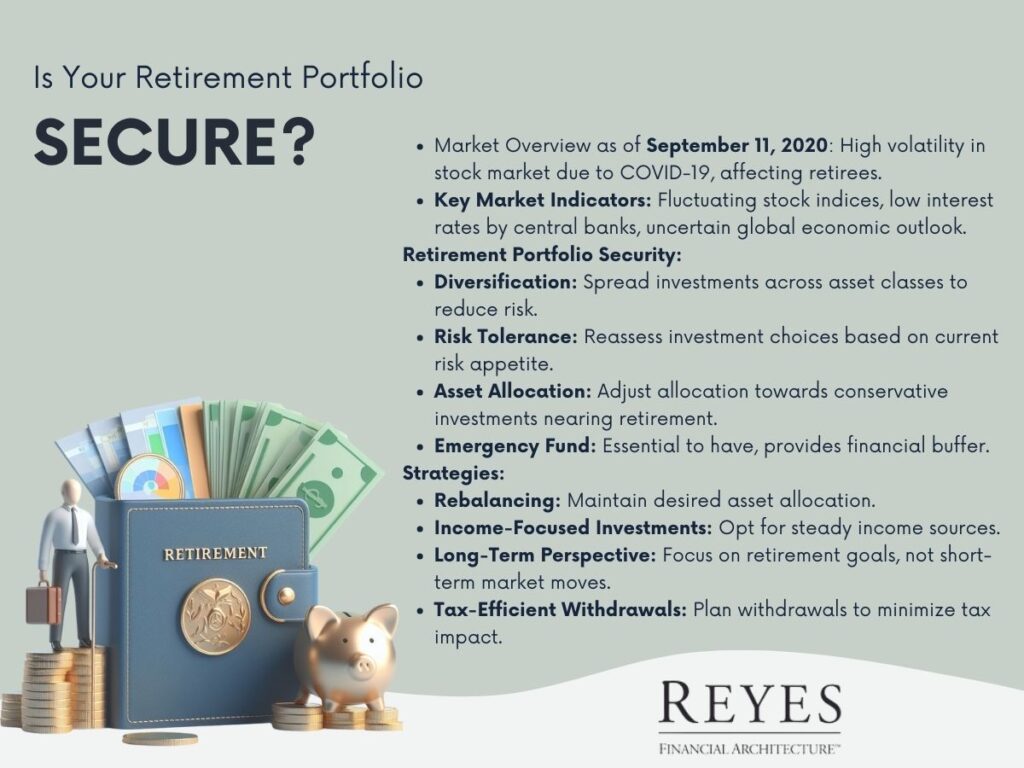
The stock market has experienced significant volatility in 2020, largely due to the uncertainty surrounding the COVID-19 pandemic. This volatility poses a particular concern for retirees, who may not have the luxury of time to recover from substantial market downturns.
Diversification remains a key strategy in managing risk. Ensure your portfolio is spread across various asset classes (stocks, bonds, real estate, etc.) and sectors to mitigate the impact of market volatility.
Your risk tolerance may have changed in response to the current market conditions and personal circumstances, such as nearing retirement. It’s crucial to reassess your investment choices to align with your current risk appetite.
Review your asset allocation to ensure it's in line with your retirement goals. As you approach or enter retirement, a shift towards more conservative investments might be advisable to protect your capital.
Having an emergency fund outside of your investment portfolio is essential. It provides a financial buffer without needing to liquidate investments at potentially low market values.
The market as of September 11, 2020, presents unique challenges for retirees. It's more important than ever to take a proactive approach in managing your retirement portfolio, considering the current economic landscape and your personal retirement goals. Regular consultation with a financial advisor can provide valuable guidance in navigating these uncertain times.
Listen to David's latest market update!
In the ever-changing world of finance, it's vital to stay informed about market conditions and make prudent investment decisions. Today, we'll delve into a recent market update and revisit an instructive historical lesson known as the "Shoeshine Boy Story." This narrative offers valuable insights that can guide your investment strategy.
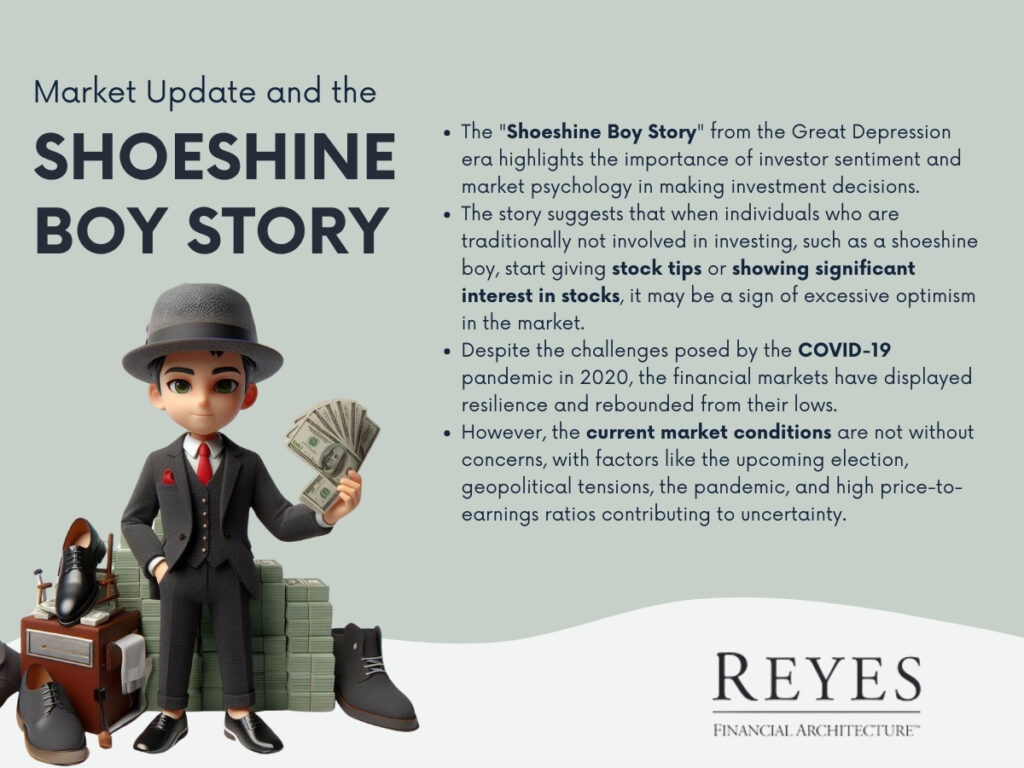
To set the stage, let's journey back to the Great Depression era when the Kennedy family, one of America's wealthiest, made a name for themselves in the financial world. Joe Kennedy, a prominent figure within the family, is often associated with a story that has left an enduring mark on investment wisdom – the "Shoeshine Boy Story."
During those challenging times, Joe Kennedy regularly sought out the services of a particular shoeshine boy. One day, this young lad approached him with a stock tip received from a friend. Joe Kennedy, somewhat amused by the situation, responded with an insight that continues to resonate with investors today: "Once the shoeshine boy starts asking about stocks, it's time to sell." Heeding this advice, Kennedy promptly liquidated all his securities, a move that proved prescient as the market crashed during the Great Depression.
The Shoeshine Boy Story imparts a crucial lesson about investor psychology and market sentiment. When optimism and enthusiasm drive the masses into the market, it often serves as a signal to exercise caution. Conversely, when fear dominates the market, opportunities may arise for those who can overcome their trepidation.
Fast forward to the present day, and we find ourselves in a markedly different financial landscape. The year 2020 witnessed unprecedented challenges due to the COVID-19 pandemic, causing significant economic turmoil. However, the markets displayed remarkable resilience, rebounding from their lows in a surprisingly short span. Nonetheless, the current market conditions are not without their concerns.
Many stocks, including technology giants like Zoom and Tesla, have experienced substantial surges recently. For instance, Tesla's stock price witnessed a staggering 250% increase. While such growth is enticing, it's crucial to acknowledge that markets have rebounded from substantial declines earlier in the year. This rapid recovery has the potential to foster excessive optimism among investors.
It's essential to exercise prudence in today's investment climate. Despite the recent rally, uncertainties persist. Factors such as the upcoming election, geopolitical tensions, the ongoing pandemic, and a historically high price-to-earnings ratio all contribute to an atmosphere of caution in the financial markets.
Investors are advised to reevaluate their portfolios, especially if they are uncomfortable with the level of risk they are taking. The current market conditions, with valuations reaching levels not seen since the dot-com bubble in 2000, warrant a measured approach. Ensuring that your investment strategy aligns with your long-term financial goals and risk tolerance is paramount.
In conclusion, as investors navigate these uncertain waters, it's essential to stay informed and make well-considered financial decisions. The lessons from the past, as exemplified by the Shoeshine Boy Story, remind us of the importance of approaching investments with a balanced perspective. Consider both the opportunities and risks in today's markets and seek professional guidance when necessary to secure your financial future.
In the ever-evolving world of finance, staying informed is crucial. A recent market update sheds light on recent developments and offers insights into what lies ahead. In this article, we'll delve into the key points of this update, highlighting the unexpected twists and turns in the market and offering guidance on what individuals should consider moving forward.
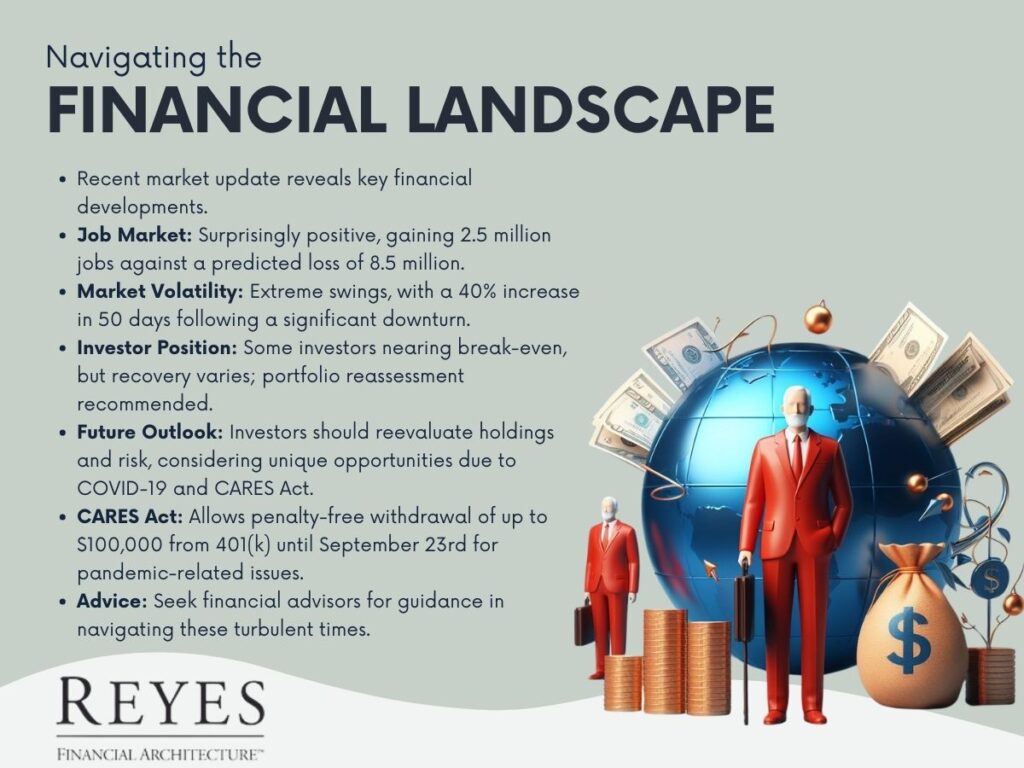
One of the most remarkable aspects of the recent market dynamics has been the surprising rebound of the job market. Experts had predicted a loss of approximately 8.5 million jobs. However, the reality was quite different, with the market gaining around two and a half million jobs. Although there are still more than 30 million people unemployed, this unexpected boost provided a ray of hope.
The market's performance in the past few months has been nothing short of astonishing. In just 50 days, it soared by over 40%, marking the largest increase in the shortest amount of time ever recorded. This rapid ascent came on the heels of a significant downturn, with the Dow experiencing nearly a 40% loss in just three weeks.
This swift turnaround reminds us of the volatile nature of the financial markets. While the recent rally is encouraging, it by no means suggests that the path ahead is free from turbulence. In fact, it serves as a stark reminder that the market remains unpredictable and unstable.
For individuals invested in the market, the recent rally may have brought them closer to breaking even. However, many may still be underwater, especially if they suffered significant losses during the downturn.
A 35% loss during this period, which was close to the market average, necessitates a rate of return in the range of 45% to 55% to recover fully. Some may have reached the break-even point, but for others, the journey to recovery remains ongoing.
This moment of relative stability presents an excellent opportunity to reassess one's financial portfolio. Those who were anxious during the market downturn can now consider reallocation strategies to not only enhance portfolio protection but also optimize potential gains in the future.
As markets continue to maintain elevated levels, it becomes imperative for investors to reevaluate their financial holdings and risk tolerance. This is an opportune time to reposition assets for potential growth while keeping a keen eye on risk management.
Moreover, there are unique financial opportunities created by the COVID-19 pandemic and the CARES Act. Until September 23rd, individuals facing financial setbacks due to the pandemic can withdraw up to $100,000 from their 401(k) plans without incurring tax penalties. Exploring options like converting 401(k) assets to tax-free Roth conversion assets can create a tax-efficient financial plan.
In conclusion, it's advisable to reach out to a trusted financial advisor for guidance and support if you find yourself facing financial challenges or simply want to explore opportunities. In these turbulent times, knowledge and preparation are your best allies on the path to financial stability and success.
Check out David on KUSI-TV discussing reasons to avoid using credit cards this holiday season.
With the holiday season fast approaching, it's essential to take steps to prevent financial strain and excessive debt. Let's discuss some valuable reasons to steer clear of using credit cards during this festive period.

Consider the decision at the grocery store checkout, where you're asked, "paper or plastic?" In this scenario, cash can be likened to paper, and credit cards to plastic.
"Cash is always king," as it is akin to environmentally-friendly paper bags and can also be friendlier to your wallet. Let's explore the rationale behind prioritizing cash for holiday spending.
Using credit cards during the holidays can lead to overspending. It's easy to lose track of your expenses when using plastic, resulting in a substantial bill by the end of the season.
Credit card-related identity theft and security breaches are a growing concern. Recent incidents involving major credit card companies have exposed countless individuals to risk. For example, one prominent credit card issuer had over a hundred breaches in a single month, and over the past decade, more than ten billion records have been compromised.
Apart from opting for cash, consider establishing a holiday budget. Start by determining the total amount you're willing to spend and then allocate funds to different categories, prioritizing your loved ones. This method helps you avoid overspending on less essential gifts while ensuring that your nearest and dearest receive meaningful presents.
With the holiday season only a few weeks away, consider allocating a portion of each paycheck to create a holiday fund. Treating your paychecks as "layaway" for yourself ensures you'll have the necessary funds when it's time for your holiday shopping.
Here are some additional tips to consider:
1. Look for Coupons: Seek out discounts and coupons to save money on your purchases. Many retailers offer special deals during the holiday season, providing opportunities for savings.
2. Shop Around: Don't settle for the first price you encounter. Compare prices and explore various stores or online retailers to find the best deals.
3. Beware of Credit Card Interest: Credit card interest rates can be exceedingly high, often exceeding 20-25%. Avoid the allure of credit card offers and choose cash to prevent accumulating substantial interest charges.
4. Black Friday Opportunities: Black Friday and Cyber Monday offer excellent chances to snag deals. However, always stick to your budget to ensure a financially responsible holiday season.
In conclusion, as the holiday season draws near, it's crucial to make prudent financial choices to prevent unnecessary debt. By opting for cash over credit cards, setting a budget, and following these money-saving tips, you can enjoy a financially secure and stress-free holiday season. Remember that cash is the safest choice for both your finances and your peace of mind.
Check David's latest market update
As we approach the holiday season, it's important to stay informed about the latest developments in the financial world. In this market update, we'll discuss recent actions taken by the Federal Reserve and introduce some intriguing investment strategies.
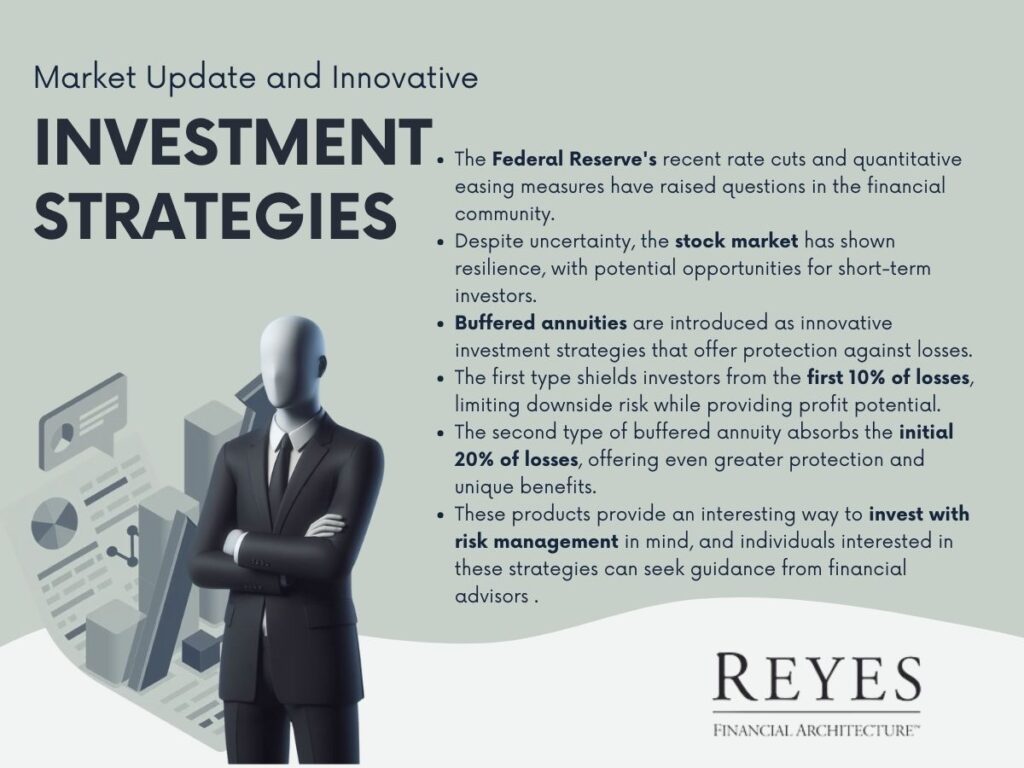
Recent changes in the Federal Reserve's policy have raised eyebrows in the financial community. The Fed has surprised many by cutting interest rates twice this year, with speculation about a potential third cut in October. What's unusual is that these rate cuts came after a period of tightening monetary policy.
Despite this uncertainty, the stock market has shown remarkable resilience, with only a slight dip from its all-time highs. However, the Federal Reserve's decision to engage in quantitative easing (QE), which involves purchasing Treasury bonds and short-term Treasuries, is unconventional given the strong market performance. QE injects liquidity into the market and can boost stock prices temporarily.
In this environment of uncertainty, short-term investors may still find opportunities in the stock market. There's a possibility that we might witness another surge before the year concludes. However, it's essential to keep a close watch on factors like the upcoming election to assess the market's trajectory.
Now, let's delve into an intriguing investment strategy: buffered annuities. These innovative products are designed to offer a level of protection for your investments.
The first type of buffered annuity shields you from the first 10% of losses. In practical terms, if your investment declines by 20%, you'll only experience a 10% loss. On the flip side, if it increases by 28%, you'll enjoy a 14% gain. This strategy limits downside risk while providing reasonable potential for profit.
The second type of buffered annuity takes it a step further. It absorbs the initial 20% of losses. This means that if the market drops by 20%, you won't incur any losses. Over a six-year period, you could potentially receive up to 500% of the S&P 500 returns. In essence, this product shields you from the first 20% of losses, offering unique protection against market downturns.
These buffered annuities may seem unconventional, but they provide an interesting opportunity to invest with a degree of protection not typically found in traditional investments. If you're curious to learn more about these innovative strategies, consider reaching out to a financial advisor for more information.
In these uncertain times, it's essential to explore investment options that align with your financial goals and risk tolerance. These buffered annuities offer a unique way to manage risk while seeking potential gains in the market.
Listen to this important video market update and reach out at (858)597-1966 for your complimentary meeting with David Reyes.
In the ever-evolving world of finance, it's crucial to stay informed about market developments, especially when unexpected changes occur. Today, we'll delve into a recent market update, touching on essential topics that could impact your portfolio and retirement plans.
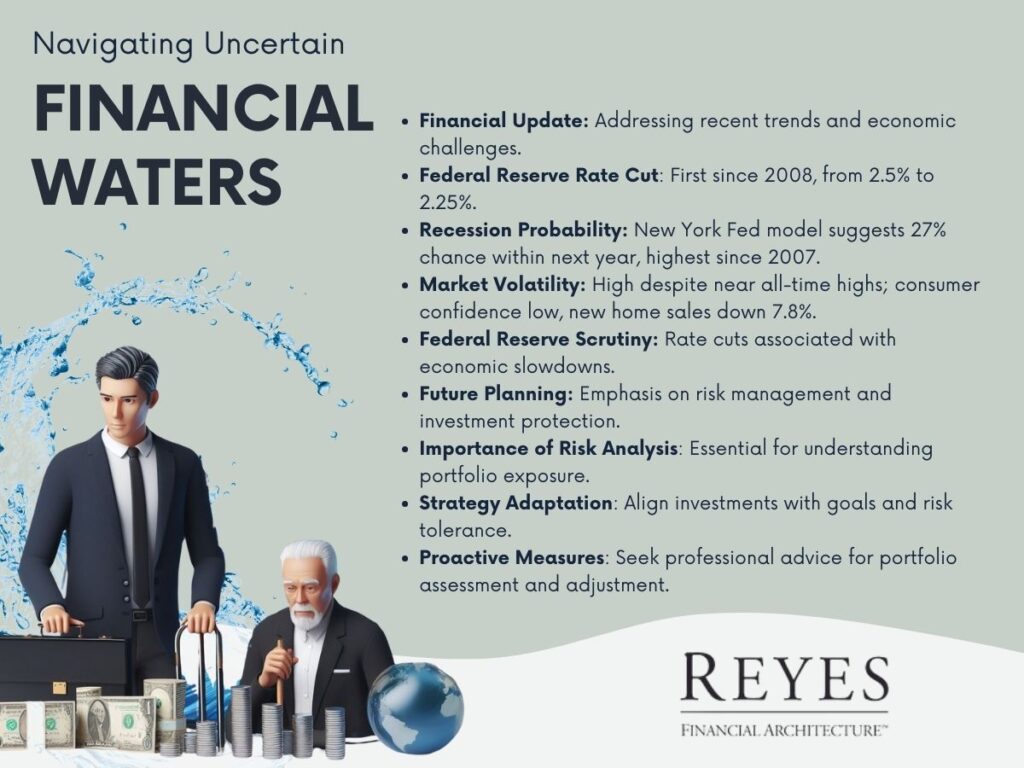
In a move that hasn't been witnessed for over a decade, the Federal Reserve recently lowered interest rates by 25 basis points, reducing the rate from approximately two and a half percent to two and a quarter percent. This marks the first interest rate cut since 2008, a period of financial turmoil that still resonates in our memories.
Historically, the Federal Reserve typically cuts rates when economic growth begins to slow down. The last two instances of a first-rate cut by the Federal Reserve occurred in 2000 and 2008, both preceding significant market crashes. While it's not a guarantee that history will repeat itself, these occurrences serve as cautionary tales, reminding us to remain vigilant.
Currently, there is about a 60% chance that the Federal Reserve will reduce rates further in the next six months by an additional 50 basis points. The global economy is showing signs of slowdown, with negative interest rates in various parts of the world, such as Germany, France, Denmark, and Japan. In some cases, individuals are required to pay fees to keep their money in banks. This worldwide trend is affecting interest rates in the United States.
Despite a relatively flat stock market over the past year, the bond market has experienced an impressive rally. Long-term Treasuries, in particular, have surged, with a 15% increase year-to-date. This rally highlights the stability and strength of the bond market, offering investors a less volatile alternative.
Additionally, gold has been on a remarkable upswing, making it another asset to consider in your investment strategy.
Given the uncertainty in the current market, caution is advised. It's not a time to be overly brave, as markets can be unpredictable. In the months of September, October, and November, historical patterns suggest potential downturns, with the possibility of a 10-20% market correction.
To navigate these uncertain waters and safeguard your portfolio while increasing your retirement income and reducing volatility, it's crucial to explore strategic financial planning options. If you're interested in learning more about how to protect your portfolio and enhance your retirement income, consider reaching out to a financial advisor for guidance.
In conclusion, the financial landscape is evolving, and it's essential to adapt your investment strategy accordingly. By staying informed and exploring diverse asset classes, you can navigate these challenges and work towards securing your financial future.
It is not if the next recession will happen, it is about when it will happen! David shares his insight about the next recession and ways on how to protect your portfolio.
Will you be comfortable loosing part of your capital? If the answer is NO, then don't wait until it is too late. Contact Reyes Financial Architecture today and schedule a complimentary Second Opinion on your portfolio.
The financial world can be a complex and unpredictable place, and staying informed is vital for making sound investment decisions. In this market update, we'll discuss several concerning trends that have emerged recently and the importance of being prepared for potential economic challenges.
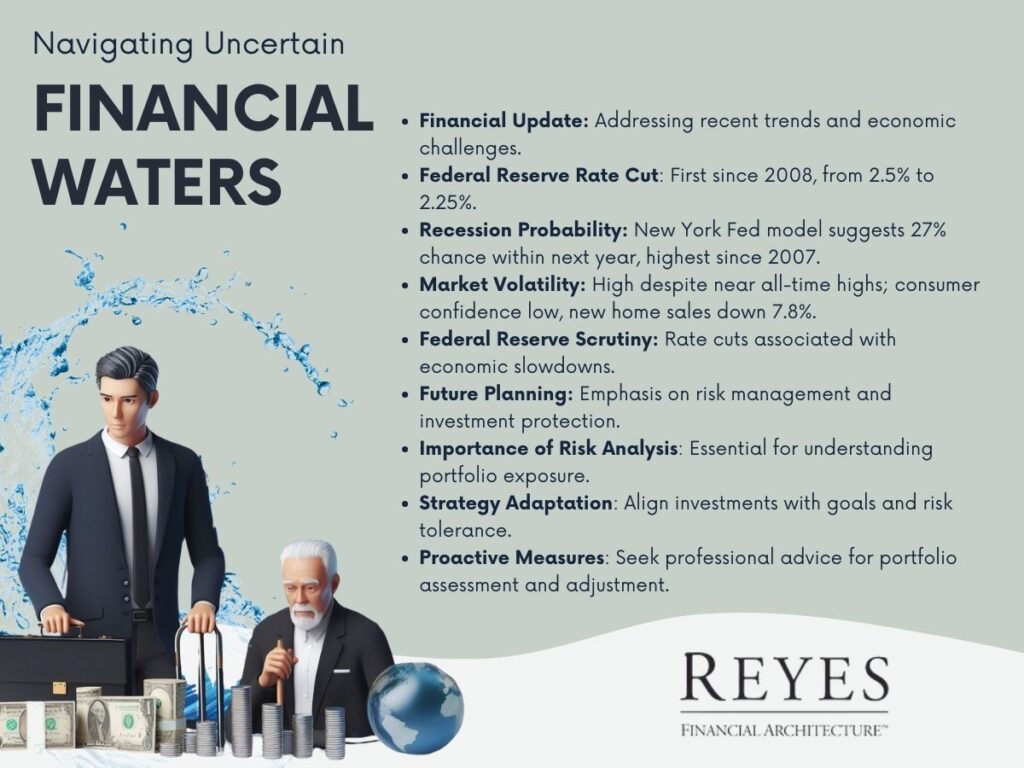
Recent developments in the financial sector have raised concerns among experts. The Federal Reserve recently made its first interest rate cut since the 2008 financial crisis, reducing rates by 25 basis points from approximately two and a half percent to two and a quarter percent. This rate cut is significant because, historically, the Federal Reserve lowers rates when economic growth begins to slow down.
An alarming statistic comes from the New York Fed's probability model, which suggests a 27 percent chance of a recession occurring within the next 12 months. This probability is the highest it has been since early 2007, just before the last financial crisis. While it's crucial not to jump to conclusions, these warning signs underscore the need for caution and preparedness.
Market history has shown us that trends often repeat themselves, even if they don't follow the same script. Several indicators have emerged that should give investors reason for concern. Despite being only about 2 percent away from all-time market highs, there is an air of fragility that cannot be ignored.
Consumer confidence, a significant driver of market performance, has recently reached its lowest level in two years. Additionally, new home sales dropped by 7.8 percent in May, despite historically low mortgage rates.
The Federal Reserve's actions are under scrutiny, particularly their decision to cut rates, which is typically associated with an economic slowdown. It's essential to remember that rate cuts aren't necessarily an indicator of positive market conditions.
In times of uncertainty, it's crucial to have a well-thought-out plan that allows you to protect your investments while ensuring that you can achieve your financial goals. Protecting your assets is just as vital as participating in market growth. Consider it similar to having insurance – you don't purchase it only when a storm is looming, but rather as a safeguard against unforeseen events.
Many investors are unaware of the level of risk they are exposed to in their portfolios. It's essential to conduct a comprehensive risk analysis to accurately quantify your potential risk. Being proactive in managing your portfolio can prevent unpleasant surprises when market conditions take a downturn.
As the financial landscape continues to evolve, adapting your investment strategy accordingly is essential. Seeking professional advice, regularly assessing risk, and ensuring your portfolio aligns with your financial objectives and risk tolerance are fundamental steps.
Avoid waiting until it's too late to make adjustments. Taking proactive measures now can position you for strength and confidence, allowing you to make informed decisions rather than reacting to unforeseen circumstances.
If you have concerns about your portfolio's risk, fees, or retirement income strategy, consider seeking a second opinion from a qualified financial advisor. A proactive approach today can help you navigate the challenges that the market may present in the future.